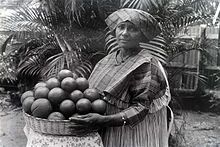 A Surinamese woman holding a basket full of fruits. Picture taken sometime within 1904–1937. | |
| General Statistics | |
|---|---|
| Maternal mortality (per 100,000) | 130 (2010) |
| Women in parliament | 11.8% (2012) |
| Women over 25 with secondary education | 40.5% (2010) |
| Women in labour force | 40.5% (2011) |
| Gender Inequality Index[1] | |
| Value | 0.427 (2021) |
| Rank | 105th out of 191 |
| Global Gender Gap Index[2] | |
| Value | 0.737 (2022) |
| Rank | 44th out of 146 |
| Part of a series on |
| Women in society |
|---|
 |
Women in Suriname are women who were born in, live in, or are from Suriname. Surinamese women may be ethnically East Indian, Afro-Surinamese (Creole) and Maroon), Javanese, Amerindian, Mixed, or of other ancestry. Many women of Suriname work in the informal sector and in subsistence agriculture.[3]
Surinamese women have been described as the "emotional and economic center" of the household (see matrifocality), particularly in Creole family groups. However, in traditionally patriarchal East Indian family groups, they have been described to act as subordinates, expected to obey cultural norms, such as not to practice living together with a partner without being married first and that the bride should maintain her virginity until consummation after marriage.[3]
In relation to caring for infants, Suriname's mothers place their babies inside cribs near them, particularly for sleeping, but they are separated into another room if already at the right age. Other child rearing practices of women in Suriname include mothers carrying their babies during the day until night time, when mothers place their babies in hammocks to sleep. Child care is different in Maroon women and Amerindian women, because they are "reluctant to let anybody touch their babies".[3] In general, Surinamese women allow their children to spend the first five to six years with them.[4]
There are Surinamese proverbs that describe women in Suriname. The saying "An old woman's soup tastes better than a young woman's breast" is an example of those proverbs.[5]
- ^ "Human Development Report 2021/2022" (PDF). HUMAN DEVELOPMENT REPORTS. Retrieved December 9, 2022.
- ^ "Global Gender Gap Report 2022" (PDF). World Economic Forum. Retrieved February 15, 2023.
- ^ a b c Suriname, everyculture.com
- ^ Suriname Facts, COUNTRYREPORTS
- ^ Suriname's Miss Alida Pageant, adventuress-travel-magazine.com
